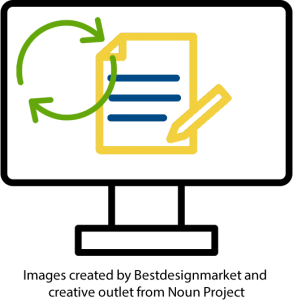
First, check the license to make sure you have the permission to modify the contents. As long as the Creative Commons license does not have a No Derivatives clause, you are able to change the contents of the book. See Creative Commons for more information on licenses.
If you wish to adapt an open textbook, you need to be able to have the textbook in a technical format that you can work with. This usually means the original source files used to create the textbook.
Common source formats for open textbooks that you should look for are:
What tools you will use to create your version of the textbook will depend greatly on what format you find the original textbook in and what you feel comfortable working with.
It is common that open textbooks may only be available as a PDF document. PDF documents are not editable. If you want to modify an open textbook that is only available in PDF format, you will need to convert the PDF document to one of the formats above.
Before you consider converting a PDF version of the textbook, you should contact the original author and asking for a copy of the textbook source files. Converting a PDF document to an editable format is a difficult, time consuming and imprecise process.
Once you have a format that you can edit, you can begin to modify the textbook. What tools you will use to do this will depend greatly on what editable format you are working with, and your comfort level with working with that format.
Once you have finished creating your own version of the textbook, you should decide on which Creative Commons license you will use to license your book. This will depend a great deal on how the original textbook was licensed.
For example, if the original textbook was licensed with SA (Share Alike) license, then you must release your book with the same license as the original source material to ensure it is fully compliant with the original CC terms of use.
Students like flexibility when it comes to their textbooks. Some may prefer printed versions of the textbook, others will prefer using a website. Still others will like to use an e-reader or e-reading software.
To make your book as accessible as possible, consider making your textbook available in multiple formats so students have the ability to choose the format that works for them. At a minimum, the open textbook project will make textbooks available as a website (HTML), ePub document for e-readers, and PDF document which students can print or choose to have printed via a print on demand service.
Once you have edited your version of the textbook, you will need a place to put your textbook where your students can access it.
The term, adaptation, is commonly used to describe the process of making changes to an existing work. Though we can also replace “adapt” with revise, modify, alter, customize, or other synonym that describes the act of making a change. Reasons for adapting or modifying an OER or open textbook can include:

How easy or difficult this will be depends on a number of factors, including;
This material is adapted from Experience Georgia and based WikiEducator. “Adapt” in OER Handbook for Educators (http://wikieducator.org/OER_Handbook/educator_version_one/Adapt) and Why Remix Open Educational Resources? created by Liam Green-Hughes, both used under a CC-BY license ↵ 
This page is modified from “6 Steps to Modifying an Open Textbook" by Clint Lalonde, BCcampus.